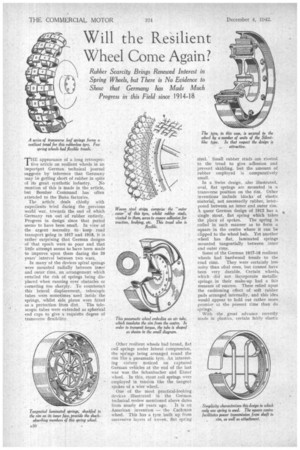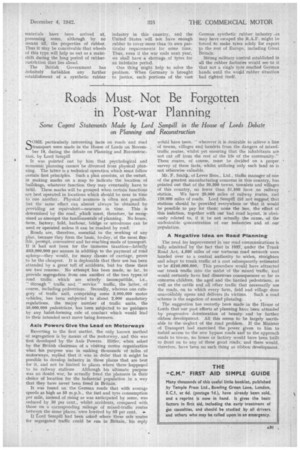Will the Resilient Wheel Come Again?
Page 32

Page 33

If you've noticed an error in this article please click here to report it so we can fix it.
Rubber Scarcity Brings Renewed Interest in Spring Wheels, but There is No Evidence to Show that Germany has Made Much Progress in this Field since 1914-18 THE appearance of a long retrospective article on resilient wheels in an important German technical journal suggests by inference that Germany may be getting short of rubber in spite
of its great synthetic industry. No mention of this is made in the article, but Bomber Command has often attended to the Buna factories.
The " article deals chiefly with expedients tried during the previous world war, towards the end of which Germany ran out of rubber entirely. Progress in design since that period seems to have been small, In view of the urgent necessity to keep road transport going in 1917 and 1918, it is rather surprising that German designs of that epoch were so poor and that little attempt seems to have been made to improve upon them during the 20 years' interval between two wars.
In many of the devices spiral springs were mounted radially between inner and outer rims, an arrangement which entailed the risk of springs being displaced when running over obstacles or cornering too sharply. To counteract this lateral displacement, telescopic tubes were .sometimes used inside the springs, whilst side plates were fitted
as a protection from dirt. The telescopic tubes were extended as spherical end caps to give a requisite degree of transverse flexibility.
Other resilient wheels had broad, flat coil springs under lateral compression, the springs being arranged round the rim like a pneumatic tyre. An interesting variety noticed on captured German vehicles at the end of the last war was the Schanbacher and Ebner wheel. In this, stout coil springs were employed in tension like the tangent spokes of a wire wheel.
One of the most practical-looking. devices illustrated in the German technical review mentioned above dates
from nearly 40 years ago. It is an AmeriCan invention — the Cachman wheel. This has a tyre built up from successive layers of woven, flat spring
steel.. Small rubber studs are riveted to the tread to give adhesion and prevent skidding, but the amount of rubber employed is comparatively small.
In a Swiss design, also illustrated, oval, flat springs are mounted in a transverse position on the rim. Other inventions include blacks of elastic material, not necessarily rubber, interposed between an inner and outer rim. A queer German design of 1912 has a single stout, flat spring which takes the place, of spokes. The spring is coiled in such manner as to form a square in the centre where it can be clipped to the wheel hub. Yet another wheel has flat, laminated springs mounted tangentially between inner and outer rims.
Some of the German 1917-18 resilient wheels had hardwood treads to the road rims. • They were certainly less noisy than seeel ones, but cannot have been very durable. Certain wheels,. which did not ilic-orporate metallic springs, in their make-up had a fair measure of success. These relied upon the cushioning effect of soft rubber pads arranged internally, and this idea would appear to hold out rather more promise at the present time than do springs.
With the great advance recently made in Plastics, certain fairly elastic
materials have been arrived at, possessing some, although by no means all, the properties of rubber. Thus it may be conceivable that wheels of this type will help us out as a makeshift during the long period of rubberrestriction that lies ahead.
The British Government has definitely forbidden any further • establishment of a synthetic rubber
industry in this country, and the United States will not have enough rubber to cover more than its own particular requirements for some time. Thus, even if the war ends next year, we shall have a shortage of tyres for an indefinite period.
One thing might help to solve the problem. When Germany is brought to justice, such portions of the vast German synthetic rubber industry .as may have escaped the R.A.F. might be forced to make tyres solely for export to the rest of Europe, including Great Britain.
Strong military control established in all the rubber factories would see to it that not a single tyre reached German hands until the woeld rubber situation had righted itself.




















































